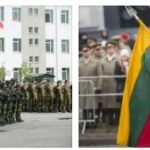Lithuania is a country of Northeast Europe. Lithuania, one of the so-called Baltic States, borders Latvia in the north, Belarus in the east and south-east, Poland in the south and the Kaliningrad enclave (Russia) in the southwest and is bathed, west, by the Baltic Sea. It has an area of 65 200 km2. The most important cities are Vilnius, the capital, with 544 000 residents (2004), Kaunas (380 100 residents), Klaipeda (193 500 residents), Siauliai (134 300 residents), Panevezys (120 100 residents) And Alytus (71 700 residents).
The climate is a transition between temperate maritime and continental temperate. Precipitation occurs throughout the year but the maximum values are recorded in the summer.
Economy
Although Lithuania has rapidly industrialized since the 1940s, the economy remains traditionally agricultural. The dominant crops are potatoes, wheat, barley, beets, rye and kale and are mainly intended for the Russian market. The country depends on imports of raw materials and fuels. The main industrial products are food products, textiles and clothing, chemicals and wool. Most exports are made up of machinery and food products. Lithuania’s main trading partners are Russia, Germany, Belarus and Poland.
Environmental indicator: the value of carbon dioxide emissions, per capita (metric tons, 1999), is 3.8.
Population
The population is 3,610,535 residents (2006), which corresponds to a population density of 55.16 residents/km2. The birth and death rates are respectively 10% and 12%. Average life expectancy is 74.2 years. The value of the Human Development Index (HDI) is 0.824 and the value of the Gender-adjusted Development Index (IDG) is 0.823 (2001). It is estimated that by 2025, the population will decrease to 3 519 000 residents. The main ethnic groups are Lithuanian (81%), Russian (8%) and Polish (7%). The religion with the greatest expression is Catholicism (79%). The official language is Lithuanian.
History
In 1386, the Lithuanian Grand Duke became king of Poland and, for this reason, the two countries formed the Polish-Lithuanian Roman Catholic Empire, for about 400 years. With the German, Swedish and Russian invasions, the empire declined and, in 1795, with the Third Partition of Poland, Lithuania came under Russian rule. In the 19th century, resistance led to peasant uprisings, massive emigration to North America and the emergence of a nationalist movement that remained active until the 1950s. In 1918, while the territory was occupied by the Germans, population proclaimed independence. After several struggles between Bolshevik Russians, Poles and Lithuanians, in 1920, the Soviet Union signed a peace treaty with Lithuania and made it independent. That year, a democratic coalition government came to power but, in 1926, a military coup ended parliamentary democracy. In 1939, the country was forced to accept the installation of Soviet military bases in its territory and, in the following year, the Soviet Red Army occupied Lithuania, which became part of the Soviet Union. Nazi Germany occupied the territory between 1941 until the Red Army liberated the territory in 1944. In the following years, the national economy was collectivized and thus followed Soviet standards. For Lithuania democracy and rights, please check intershippingrates.
When Mikhail Gorbachev began to liberalize the Soviet regime in the mid-1980s, Lithuanian nationalism resurfaced. In 1990, the country declared independence and, a year later, it achieved total independence. Currently, Lithuania’s economic choices reveal a certain contradiction, as privatizations exclude strategic sectors, such as transport, energy, communications and ports.
Lithuania formally joined the European Union on 1 May 2004 at a ceremony held in Dublin.
- Countryaah.com: Offers a full list of airports in the country of Lithuania, sorted by city location and acronyms.
- Abbreviationfinder.org: Provides most commonly used abbreviations and initials containing the country name of Lithuania. Listed by popularity.
1UpTravel.com – Maps of Lithuania
Browse a collection of country, political, shaded relief, thematic and historical maps of this European country. Check out the maps of Baltic states and region.
Website: http://www.1uptravel.com/worldmaps/lithuania.html
Lithuania – Atlapedia Online
Features two professional maps of Lithuania – one political, the other physical – to view and print. Plus, review a collection of country facts.
Website: http://www.atlapedia.com/online/countries/lithuan.htm
Lithuania – Expedia Maps
Access a detailed country map and peruse interactive tools that allow for zooming, printing, emailing and saving map views.
Website: http://maps.expedia.com/pub/agent.dll?qscr=mrdr&lats1=55.150
Lithuania – InfoPlease.com Map
Click to look at a high-end graphical map of Lithuania that offers a close-up view, making it easy to locate major cities and towns countrywide.
Website: http://www.infoplease.com/atlas/country/lithuania.html
Lithuania – Merriam-Webster Altas
Peruse a compact altas for this European country, with a detailed map, ethnic breakdown, country facts and a historical overview.
Website: http://www.m-w.com/maps/lithuania.html
Lithuania – National Geographic Map Machine
Discover a political and topographical map of the tiny Baltic nation, along with an economic and geographic overview.
Website: http://plasma.nationalgeographic.com/mapmachine/index.html?i
Lithuania – University of Texas Library
Choose from the college’s collection of topographical, historical and land-use maps, most originating from the CIA.
Website: http://www.lib.utexas.edu/Libs/PCL/Map_collection/lithuania….


